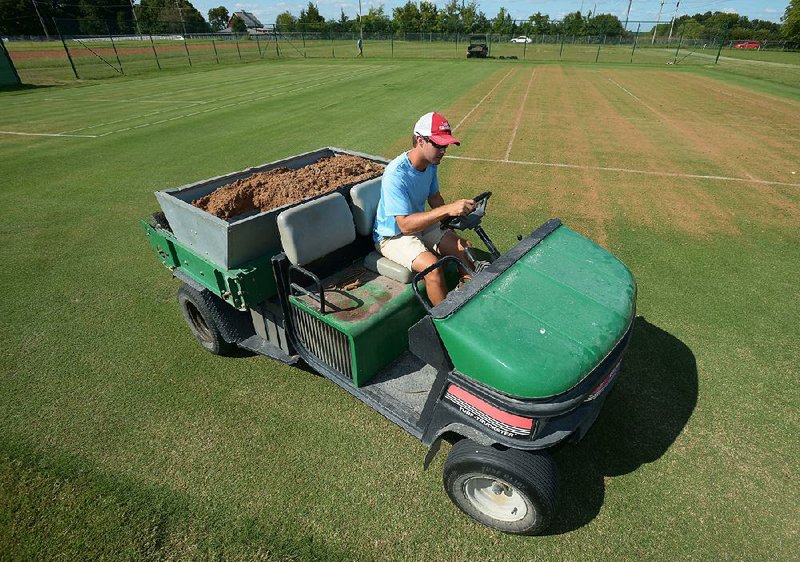Turf scientists in Fayetteville have made it possible for Arkansas tennis players to try their serves and volleys on grass courts as they would at Wimbledon.
After a year of testing how much wear a pair of outdoor grass tennis courts can withstand, horticulturist Douglas Karcher and a team of researchers decided that hitting balls there a few times a week wouldn't do. To get more use out of the courts, they agreed to make the public part of their ongoing study.
"Anyone who wants to play on public grass, they can make a reservation for a two-hour time slot," Karcher said. "It will help us get more wear to better evaluate how much a grass court can take in our region."
As part of the work being done for the University of Arkansas System's Division of Agriculture, the researchers opened two courts to the public so they can develop management practices for lawn tennis courts.
"The people who find out want to play on the courts immediately," horticulturist Mike Richardson said. "It is unique and historically, [grass] was the only tennis court you could play on."
The idea came three years ago after Karcher and Richardson, professors of the Dale Bumpers College of Agriculture, Food and Life Sciences at the University of Arkansas, Fayetteville, visited some grass courts in their travels throughout the United States, Australia and Great Britain. Tennis players themselves, the professors said they would attend conferences and meetings and sought out grass courts because they aligned with their studies. Eventually, they began to wonder if they could garner funding and build their own courts in Northwest Arkansas. For research, of course.
"We were starting to look into the science behind it and one of the things we discovered is there wasn't a lot of research that had been done," Richardson said. "Most people who managed these courts, it had been learned over years and years of trial and error to see what worked in their climate."
They wondered whether grass courts are feasible in Arkansas. With limited research available, they improvised and took a cue from how the field is managed at Baum Stadium, where the Razorbacks play baseball in the spring.
In peak season, perennial rye grass is sown; which is then oversown with Bermuda grass in the warmer off-season months. With this practice, Karcher said they are able to extend outdoor game play with grass native to the state.
"We just have a much longer outdoor season for play," he said. "Once we can demonstrate it's feasible, then we'll get into more research about best management and fertilizer practices."
The team began overlaying rye seed to the tennis courts last week in preparation for the cooler months. Along with baseball fields, Karcher said perennial rye is the type of grass used on the courts at Wimbledon.
"There's a handful of grass courts in the U.S. -- Period," said Deanna Garretson, executive director of the U.S. Tennis Association in Arkansas. "To have some in Arkansas that people can play on is a great opportunity."
Every other day at the lawn courts in Fayetteville, Tyler Carr mows the grass to a desired height of 0.35 inches. If it's too high, then the court's soft. If it's too short, then it's tough.
Carr, a graduate-level horticulture student at the University of Arkansas said golf resorts and country clubs are ideal prospects once the research is complete because they already have the equipment to take care of the facilities.
"I believe that parks could get on board too, depending on the budget and equipment," he said. "The biggest upkeep will be the mowing and, depending on the play, putting a lot of the fertilizer out to make it grow."
In his spare time he helps manage the lawn courts a few miles north of campus. Since opening them to the public, he said foot traffic has increased to roughly five games a week and the response has been mostly positive.
"It's one of those things you don't normally get to experience," Carr, 23, said. "There are a lot of players that won't ever experience tennis on a grass court. I think that's what players enjoy the most: It's the same game they love but it plays differently."
Novelty is part of it too. According to the American Sports Builders Association, which compiles information about field sports, about 1 percent of the tennis courts in the United States had grass surfaces in 1991. Most in the country are owned by resort hotels, tennis or country clubs along the east and west coasts and require a membership or fee for use.
"I don't know why there's not more lawn tennis courts," Karcher said. "It's a lot easier on the joints, it's a cooler surface, it doesn't absorb as much bounce from the ball. So strategically, it's different. And I think it's got a lot of potential."
The U of A Lawn Tennis Center is at the Arkansas Agricultural Research and Extension Center in Fayetteville, east of the Washington County Fairgrounds near Garland Avenue and Cassatt Street. The public can register to play for two-hour slots at the outdoor grass courts from 11 a.m. to 5 p.m. on weekdays for $37, or weekends for $50. The fees will go toward research and maintenance costs of the facility.
SundayMonday Business on 09/16/2018
